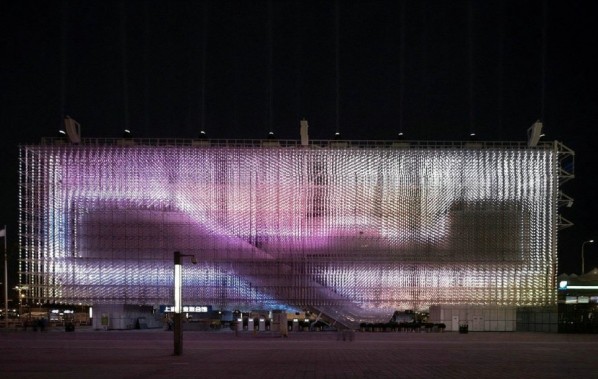
Yung Ho Chang, Shanghai Corporate Pavilion for the Shanghai World Expo, 2010. Courtesy of Atelier FCJZ and Nic Lehoux
YUNG HO CHANG: MATERIAL-ISM is a comprehensive retrospective of the groundbreaking, cross-disciplinary work of China's first international architect, Yung Ho Chang, and his practice FCJZ/Feichang Jianzhu. For this exhibition, Chang and FCJZ will transform UCCA’s Great Hall into an updated hutong neighborhood, containing six courtyard-like modules that each address a different aspect or focus of Yung Ho Chang's practice, including inhabitation, construction methods, urbanism, tradition, perception, and culture. The exhibition also includes several of FCJZ’s installations conceived and originally displayed in the contemporary art context, as well as two new films.
A systematic presentation of FCJZ's experiments in architecture, design, planning, and art, this exhibition explores the specific predicament of people, the buildings they inhabit, and the cities they constitute in this period of China's unprecedented growth. FCJZ offers witty, thoughtful, and universal design solutions that are at once distinctly Chinese, deeply humanist, and thoroughly cosmopolitan.
Yung Ho Chang is one of the world's most closely watched Chinese architects. Born in Beijing in 1956, he spent 15 years studying and teaching in the United States before returning to open Atelier FCJZ in 1993. He received degrees in environmental design and architecture from U.S. colleges including the University of California, Berkeley. He is the recipient of numerous awards including the 2000 UNESCO Prize for the Promotion of the Arts. In 2002 and 2003, he held the Kenzo Tange Chair at Harvard University's Graduate School of Design. ?Translated as "unusual architecture," FCJZ (feichang jianzhu) was Beijing's first private architectural firm and its steady stream of innovative projects—including buildings, exhibitions, and publications—has helped define a broad notion of what Chinese architectural practice can and should be.
FCJZ projects range from private residences to large- and small-scale museums, government buildings, urban planning projects, and installations at the Venice Biennale and Centre Pompidou in Paris, as well as experimentation in furniture and graphic design. In 1999 he set up the Graduate Center of Architecture at Peking University, which he has headed ever since. He also lectures at several schools in the U.S. and travels frequently through Asia, Europe, and North America. For further information, please visit www.fcjz.com ?(English introduction to major projects).
Together with FCJZ, he has published eight books and monographs, including Yung Ho Chang / Atelier Feichang Jianzhu: A Chinese Practice and Yung Ho Chang: Luce chiara, camera oscura.
He has participated in the Venice Biennale five times (first in 2000), among several other international exhibitions of art and architecture. He has taught at architecture schools across the US and China, was a professor and founding head of the Graduate Center of Architecture at Peking University (1999-2005), and held the Kenzo Tange Chair at Harvard University (2002) and the Eliel Saarinen Chair at the University of Michigan (2004). In 2011 he became a Pritzker Prize Jury member.
Atelier FCJZ has always believed in the value and craft of design with an emphasis on research and methodology. Since its inception two decades ago, FCJZ has become a multi-disciplinary practice whose outputs range from community to jewelry.
FCJZ received the Progressive Architecture Citation in 1996 for a hillside housing project in Southern China, a WA China Architecture Award in 2004, and a Business Week / Architectural Record China Award in 2006 for Villa Shizilin. Abroad, FCJZ held solo exhibitions of its work at Apex Art in New York in 1999, Harvard University in 2002, Chambers Gallery in 2005, and MIT in 2007. They were also invited to create an installation in the central court at London’s Victoria & Albert Museum in 2008. The firm has participated in numerous international art and architecture exhibitions and biennials, such as Cities on the Move in Vienna, London, New York, and Denmark; and three times at the Guangju Biennale since 1997. Products and architectural models by FCJZ are in the permanent collection at London’s Victoria & Albert Museum and the National Art Museum of China.
About the exhibition
Date: Sep 30, 2012 – Dec 2, 2012
Venue: UCCA Great Hall
Courtesy of the artist and UCCA, for further information please visit www.ucca.org.cn.




























